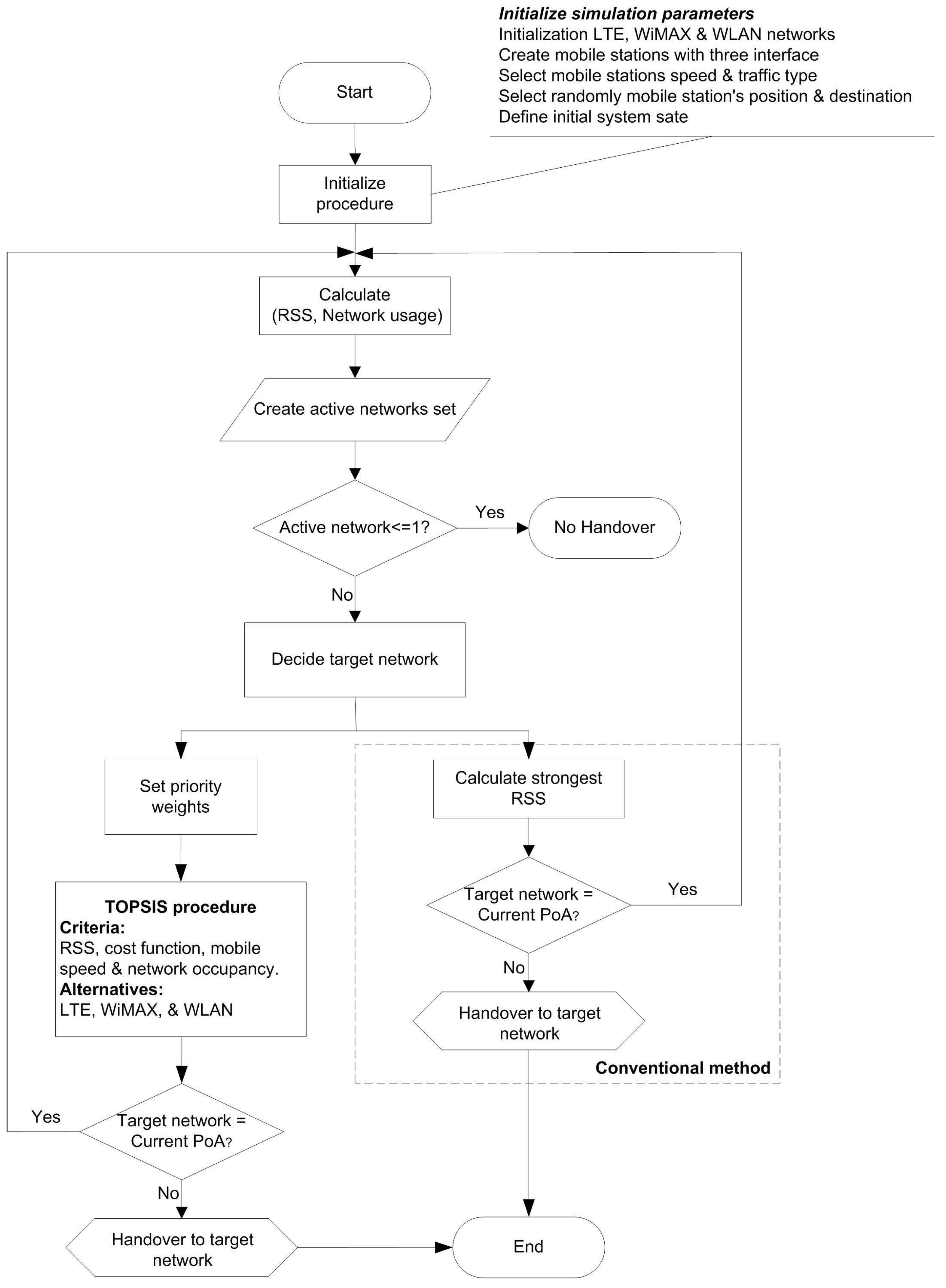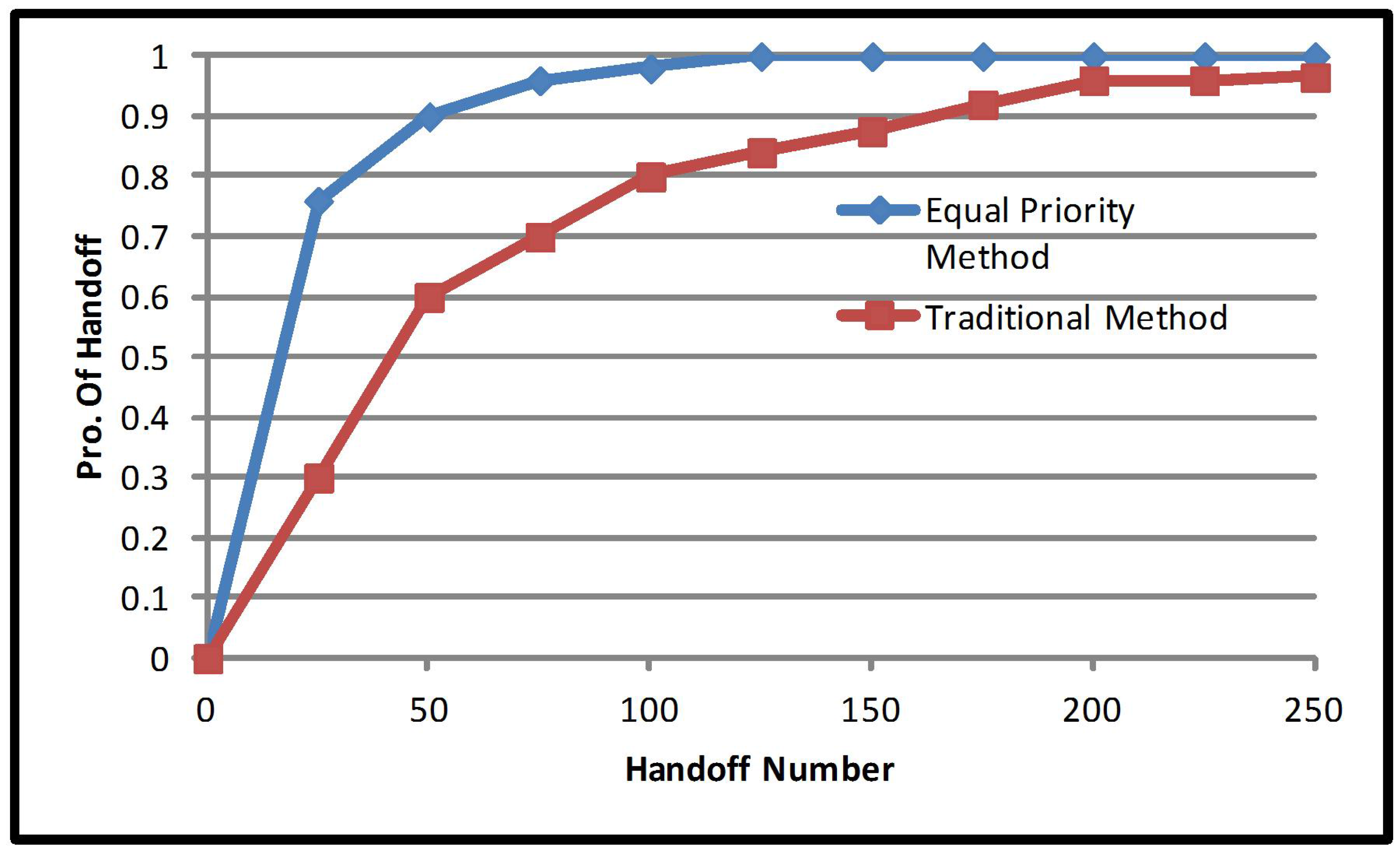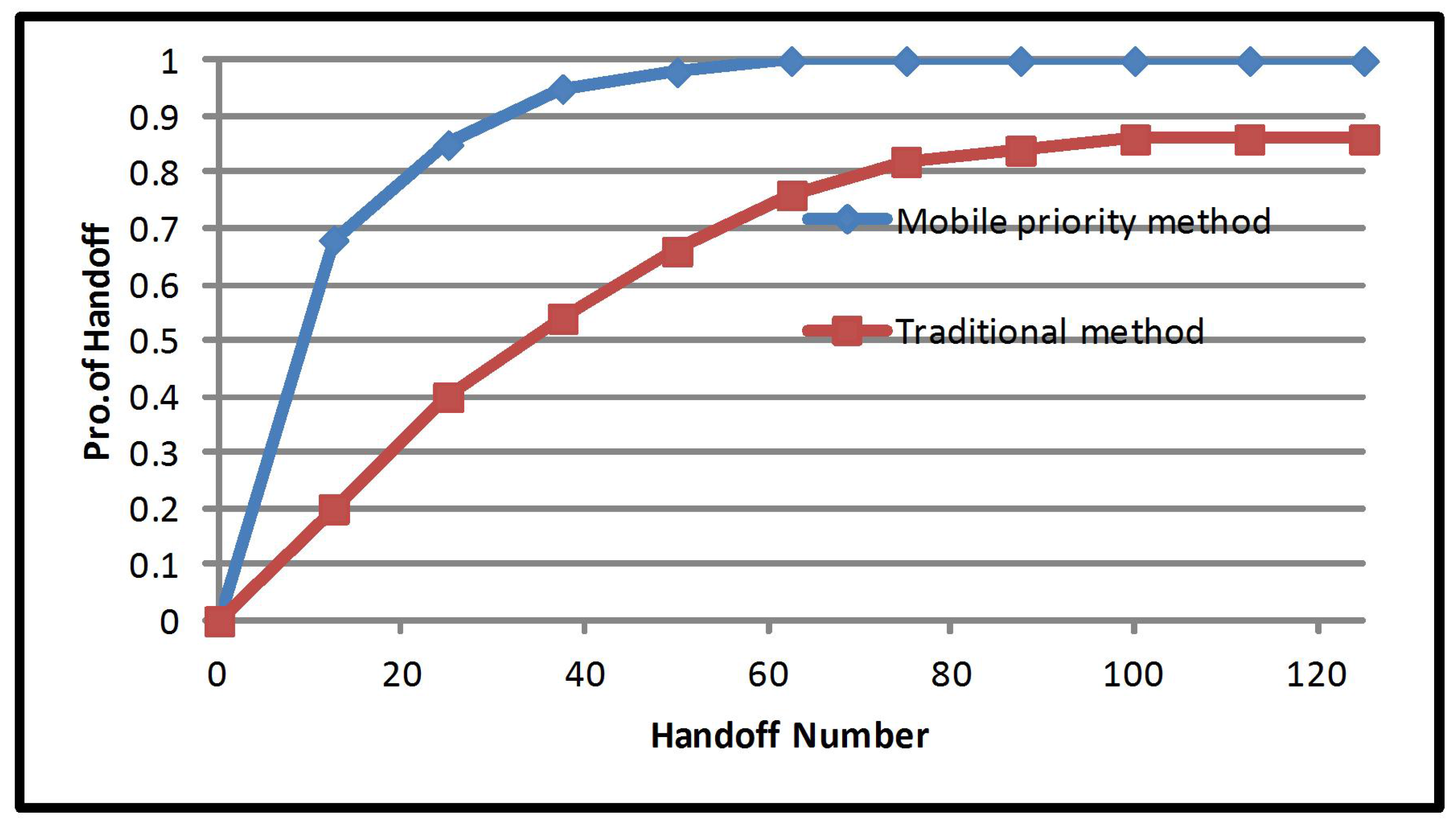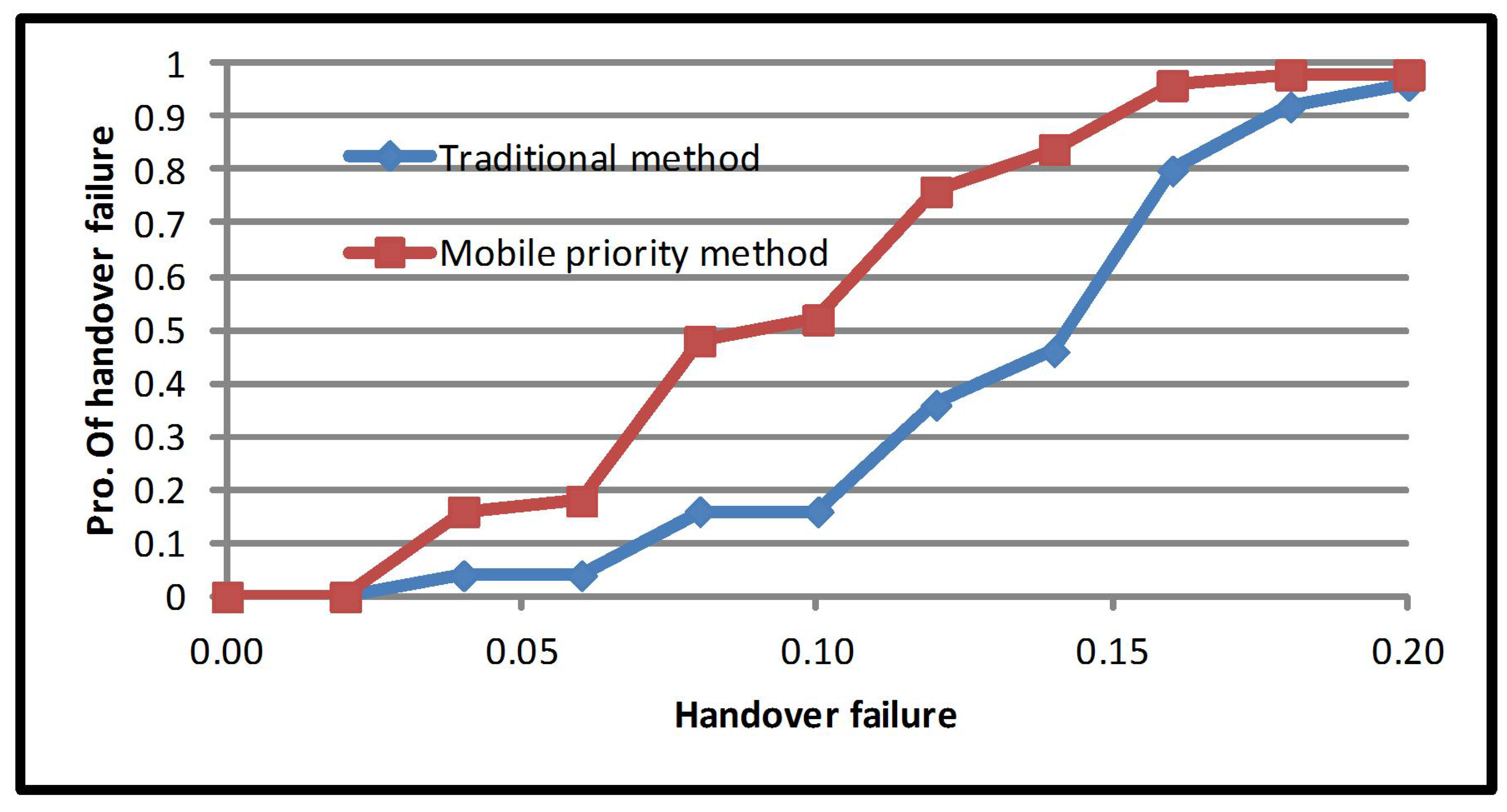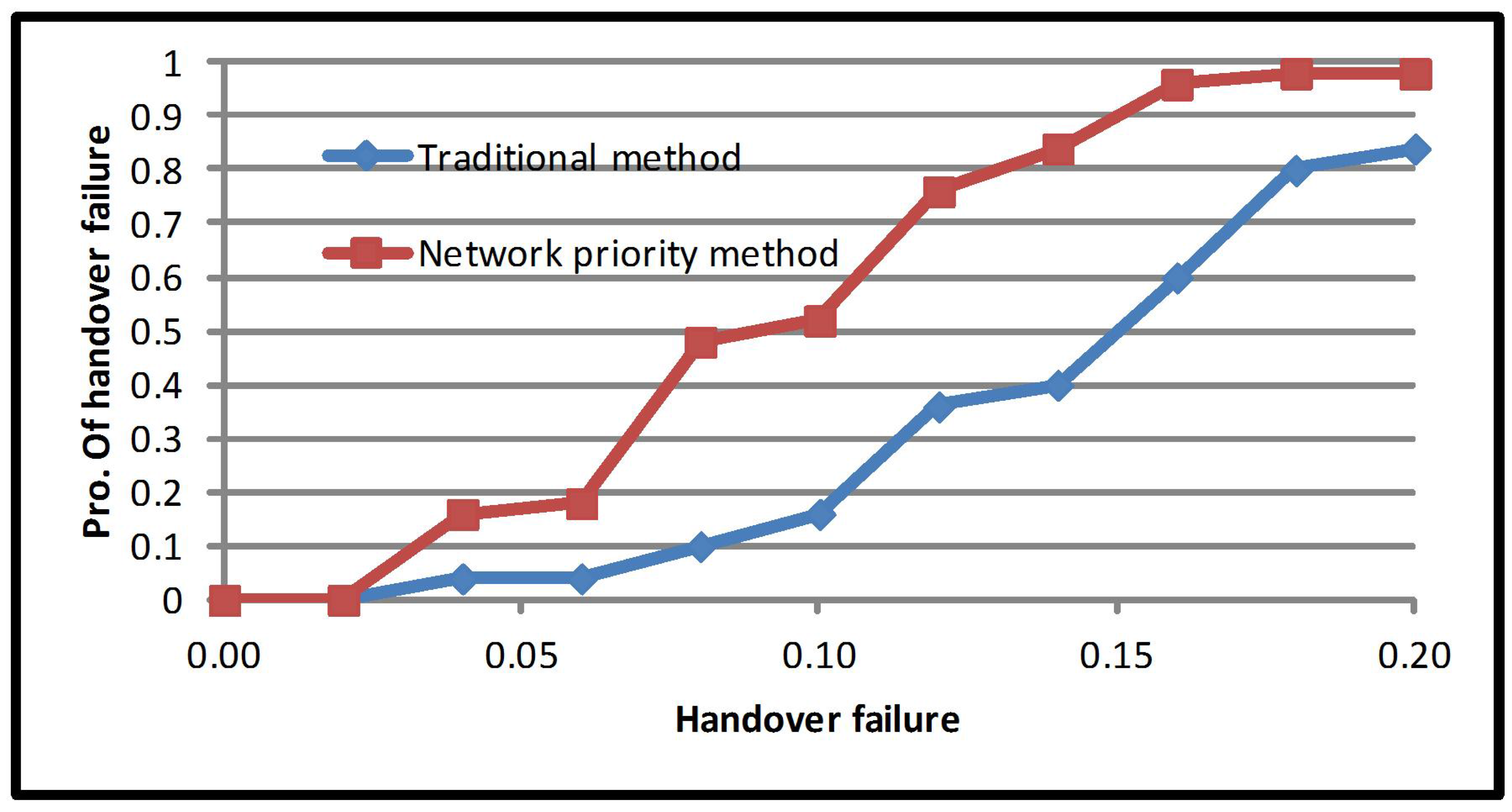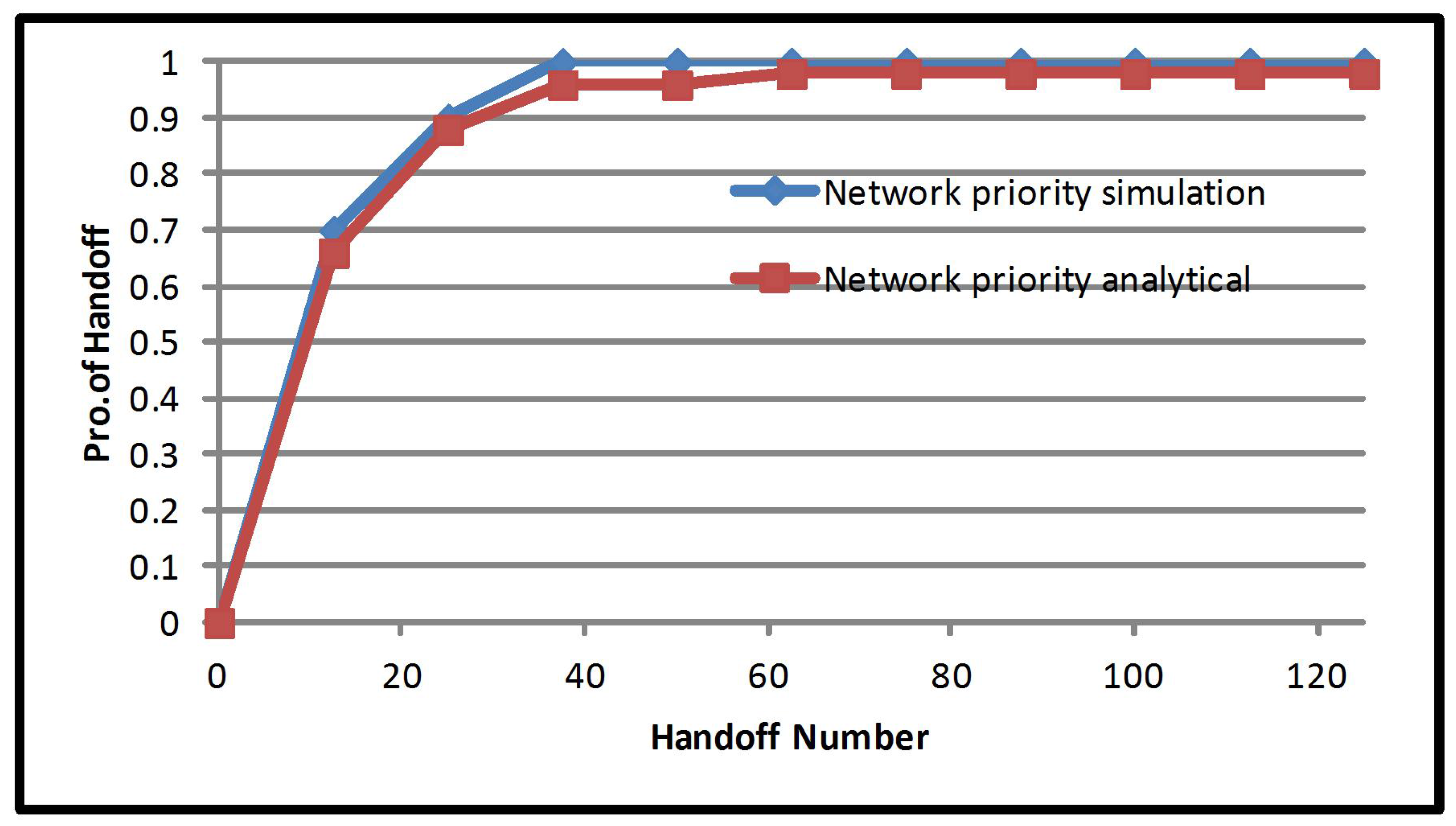1. Introduction
The demand of data transfer rate and traffic capacity of mobile communication is growing rapidly; thus, the concept of the heterogeneous network is introduced to meet this demand. In a heterogeneous network, the mobility feature is essential because mobile devices must be able to roam throughout the network and to connect to various radio access technologies. Conventionally, the mobile device is considered the point of attachment based on single criteria, such as Received Signal Strength (RSS). General opinion has been that the simplest algorithm to determine handover is based on RSS [
1], but RSS fluctuates, making it unreliable [
2]. This is caused by each element in a heterogeneous network having different thresholds of RSS, causing high packet delay, excessive handover, high handover failure probability and decreasing overall throughput in the RSS-based algorithm. Furthermore, vertical handover has several issues that are worth noting. They are as follows:
The algorithm should be reliable; an inaccurate vertical handover decision may cost network resources.
The algorithm should be able to distribute mobile devices fairly; this is to balance traffic loads on the networks.
The algorithm should be accurate; it must be able to identify the need to increase data transfer rate to mobile devices on the network.
Moving on, implementing multiple criteria on the algorithm of vertical handover helps to provide an alternative network that might be the best network target. The rest of this paper is organized as follows: a brief related work of the approaches in the network selection area is given in
Section 2, followed by the description of the multiple criteria handover decision algorithm in
Section 3. The simulation methodology is described in
Section 4.
Section 5 presents the results with the related discussions.
Section 6 presents an analytical model for validating the simulation results; finally, the conclusions constitute the last section.
2. Related Work
There are several methods of vertical handover decision algorithm, as follows:
RSS-based algorithms: This method uses the RSS algorithm as the handover trigger [
3] and to decide handover [
4]. The RSS-based algorithm has been optimized by adapting the RSS threshold [
5] and by combining the RSS threshold with the user’s velocity and location [
6].
Context-aware-based algorithms: Handover is decided based on signal quality, the network and the context of the mobile device [
1]. Context can be defined as the situation of an entity [
7] or a location, environment, identity and time [
8].
Cost function-based algorithms: This method can be approached in two ways: network-related cost function and user-related cost function [
9,
10]. Variables involved in the user-related cost function are security, monetary cost and power consumption [
11,
12].
Fuzzy logic-based algorithms: The two steps involved are: (a) fuzzification and weighting procedure [
13]; (b) decision making. This step uses Multi-Attribute Decision Making (MADM) [
14,
15].
Multiple criteria-based algorithms: This method combines the multiple criteria-based algorithms to reduce power consumption [
16,
17,
18].
Generally, RSS-based algorithms are the least complex system (
Table 1), but it is also the least accurate. Meanwhile, algorithms, such as fuzzy logic and cost function, are highly complex, but they are also highly accurate and provide higher network efficiency. So far, there has been much research done on multiple criteria vertical handover decision algorithms. It is found that they can make a quantitatively-calculated decision using some criteria of the candidates [
19]. This conclusion is derived by comparing Multiple criteria Exponent Weighting (MEW), Simple Additive Weighting (SAW), the Technique for Order Preference by Similarity to Ideal Solution (TOPSIS) and Grey Relational Analysis (GRA) [
20]. Their performance in handover efficiency is also examined [
21,
22].
The comparison has been simulated in the heterogeneous network environment of WLAN, UMTS (Universal Mobile Telecommunications Systems) and GPRS. Then, a comparison of network performance (BER, delay, jitter and bandwidth) has been carried out. There is also a comparison and a performance evaluation of SAW and the Weighted Product Model (WPM) in terms of processing delay [
23] in the environment of WLAN and Worldwide interoperability for Microwave Access (WiMAX). The results indicate that WPM has better accuracy in choosing a target network compared to SAW. Another multiple criteria algorithm, ELECTRE, has been implemented as the vertical handover decision and evaluated using numerical analysis. ELECTRE (Elimination et Croix Traduisant la Realite, or elimination and choice expressing reality) is compared to the algorithm of SAW and TOPSIS [
24,
25]. It should be noted that the appropriate choice of the criteria is crucial to ensure decision accuracy. There are many criteria, user-related or network related, such as RSS, mobility, application and bandwidth.
3. Multiple Criteria Handoff Decision Algorithm
Moving on, TOPSIS has several advantages over other multiple criteria algorithms. Its concept is simple: it has an efficient computing characteristic and is able to measure relative performance for each alternative [
26]. Furthermore, it only requires one subjective input to calculate the decision. During simulation, compared to other algorithms, TOPSIS provides higher throughput and lower packet loss [
27]. In a different perspective, the handover decision algorithm is composed of four criteria: RSS, cost function, mobile speed and network occupancy. Moreover, the algorithm needs the network (network topology and radio) and mobile (cost function and mobile speed) as the input. More details about the network parameters are explained in the next section.
There are two mobile station parameters in this study: cost function and mobile speed.
There are three types of cost function, listed as follows:
Gold cost: A premier user subscription that allows the use of the highest-level of Quality of Service (QoS). The cost function is irrelevant.
Silver cost: A medium priority user subscription that would try to balance between QoS requirements and cost function.
Bronze cost: A lower user subscription where the cost function is significantly more important than any QoS parameters.
There are five different mobile speeds between the low speed vehicular mobile station (5 m/s) and the high speed vehicular mobile station (25 m/s) [
25].
Figure 1 illustrates the flowchart of the handover decision algorithm to select the networks.
The TOPSIS method provides flexibility in defining the weights of the multiple criteria priority. There are three types of priority in the multiple criteria vertical handover decision: equal priority, mobile priority and network priority. The priority method emphasizes the mobile parameter (cost function and mobile speed); meanwhile, network priority emphasizes network occupancy. Each priority has a certain weight, as presented in
Table 2.
In these three types of priorities, we utilize the weights to compute the expected impact of each criterion on selecting the most appropriate network for handover purposes. This is performed by employing the TOPSIS method to compare between the available candidate networks. Suppose there are M alternatives (options) of candidate networks available for handover selection. Building on the previous discussion, TOPSIS will be the method for selecting the most appropriate network for handover. The steps are as follows [
25]:
Construct the normalized decision matrix: to transform dimensional attributes into non-dimensional ones. This will allow comparison across criteria, using the following equation:
where
represents the non-dimensional matrix.
represents the score of option i with respect to criterion j.
m represents the alternatives (LTE, WiMAX and WLAN).
n represents the criteria (RSS, cost function, mobile speed, and network occupancy).
Construct the weights decision matrix. The TOPSIS method is used to multiply each column of the normalized decision matrix by the weights. An element of the new matrix is:
where
W represents the weight
Determine the ideal and negative ideal solutions.
- (a)
Ideal solution:
where
- (b)
Negative ideal solution:
where
Calculate the separation measures for each alternative.
- (a)
The separation from the positive ideal alternative is:
- (b)
The separation from the negative ideal alternative is:
Calculate the relative closest to the ideal solution.
where
Rank the preference order.
A set of alternatives can now be preference ranked according to the descending order of .
4. Simulation Algorithm
To obtain performance results, the proposed algorithm is implemented by using NS-2 simulation (UPM Lib., Selangor , Malaysia) [
28]. We implemented the traditional network according to the RSS method in vertical mode. Actually, almost all of the research papers and real deployments are focused on a single metric like RSS because this information is measured in almost all mobile devices when this method is applied for implementation in the handover aspect due to the cost and simplicity. Therefore, to investigate the effectiveness of our proposal, the simulations are conducted in comparison with this product and taken as the benchmark for the analysis of the handover process. After that, an evaluation of the handover efficiency is done by examining the probability of the success and failure of handover.
Moving on, handovers are calculated based on the total vertical handover occurrence during an active call. It is crucial in assessing a mobile network’s performance as it is influenced by signaling load and delivery of QoS. It is worth noting that unnecessary handover will waste network resources and time, consequently contributing to inefficiency. The handover failure probability is the average of the incoming handover requests that cannot be serviced due to the lack of resources.
The network topology consists of the LET, WiMAX and WLAN networks. The radius of WiMAX is 2500 m, LTE 1000 m and WLAN 300 m. WiMAX covers 75% of the simulation area; meanwhile, LTE covers 65%, and WLAN covers 75%. The radio parameter is presented in
Table 2. The tracks of MNs are randomly paths [
28]. The User Datagram Protocol (UDP) is used to transmit 4960 bytes of video and 320 bytes of audio traffic between MN and CN. Meanwhile, the inter-packet transfer duration is 0.004 s. The simulation time is set at 480 s, while the results are computed by taking the average speed of 10-times executing the scenario. Simulations are done using 15 random mobile node trajectories across LET, WiMAX and WLAN networks.
5. Results and Analyses
Looking at a different point of discussion, there are three types of priorities to be considered in the multiple criteria handover decision. They are equal priority, mobile priority and network priority, and they are implemented in a heterogeneous network environment. Each priority performance is compared to the traditional method, which only considers RSS as its criteria: the multiple criteria method considers the cost function, mobile speed and network occupancy.
Figure 2 presents the number of handover allocations of equal priority multiple criteria, for 100 mobile users. Equal priority has been proven to reduce the number of handover by 22.9%; the number of handovers are reduced to 33 from 44 after implementation of equal property multiple criteria. This improves network efficiency and increases resource availability.
Figure 3 presents the number of handovers after the implementation of mobile priority multiple criteria. Mobile priority reduced the number of handovers by 40.29%; the number of handovers from 44 to 30 after the implementation of mobile priority multiple criteria.
The number of handovers for network priority multiple criteria is presented in
Figure 4. The improvement is 60%, where the number of handover averages for traditional method are 44 and the number of handover averages for network priority multiple criteria is 25. Building on the previous discussion, the traditional method of vertical handover decision produces a higher volume of handovers. This leads to the increase of signaling load on the network. As shown in the previous paragraph, the mobile priority multiple criteria method performed better than the equal priority and network priority. The weights of mobile priority multiple criteria have a large ratio on the cost function and mobile speed. Mobile speed is linked to the number of handovers, where mobile users with higher speed are more likely to experience a ping pong effect. This proves that focusing on the cost function and mobile speed reduces unnecessary handovers.
Figure 5 presents the average handover failure probability for the equal priority multiple criteria method. Handover failure probability is a fundamental performance metric because it indicates the ability of the network to serve incoming mobile users. However, equal priority multiple criteria improved the average handover failure probability by 24.62%. The average handover failure probability for the traditional method is 0.24, and the average handover failure probability for equal priority multiple criteria is 0.18. Equal priority has an equal proportion for all criteria (mobile criteria and network criteria); meanwhile, the handover failure probability is closely related to the network.
Apart from that, providing larger network occupancy and mobile priority multiple criteria can improve handover failure probability; the average increased by 33.79%. As demonstrated in
Figure 6, the average probability value for the traditional method is 0.27, while for mobile priority multiple criteria, it is 0.18. The network priority multiple criteria significantly improved the average handover failure probability by 43%. Meanwhile, the average handover failure probability is 0.27 for the traditional method and 0.15 for the network priority multiple criteria method. From this, it can be concurred that the average handover failure probability is linked to network occupancy. It should be noted that in the network priority multiple criteria method, the load on the network is higher than RSS, cost function and mobile speed. Hence, prioritizing the network will reduce the average failure probability (
Figure 7).
6. Analytical Model
The number of handovers can also be defined as the number of handovers requested during a call connection. Such requests affect the handover arrival traffic and call admission control policy design [
29]. This is why the number of handovers is chosen as a parameter to assess algorithms. The definition of call holding time and the call residence time (
Figure 8) should be clear in an analytical model.
Call holding time (): the duration from the accepted call instant to the call completed instant.
Network residence time in the origination network (): the mobile user travel duration from the original call point to the edge of the network.
Network residence time in the handover network (, i = 2, 3, 4, …): the mobile user travel duration through a network (edge to edge) reached after (n −1, n = 2, 3, 4,…) handover(s).
This paper will now focus on the configuration of the calculation of the number of handovers.
Let (NH) = the number of a non-blocked calls during a call connection. Then:
If the network residence time in the original network r1 is longer than the call holding time (), NH = 0.
If the call is terminated because of the first handover failure or the call makes the first successful handover and is completed successfully in a new network, NH = 1.
Apart from that, a non-blocked call handover probability (
) is as follows.
where
is the handover failure probability because of the lack of resources. Then, it can be simplified as follows:
To find the approximating of network residence times (
) for mobile nodes, we will use the probability density function (
) [
29].
Assume that the random variable = (). Then:
The residence time in the first network
is the gamma distributed random variable that has the same mean as
[
30].
The residence time in all subsequent networks is the gamma distributed random variable that have the same mean
and variance
.
and:
where
is the random variable x and
.
Hence, the mean and the variance of the random variable
may be found from Equation (
11), respectively, as:
Solving Equation (
12) for
, we have:
Similarly, for the residence time in the first network, we have
, and letting
, we have:
It can be seen that
is the sum of (
) gamma distributed random variables with the same shape parameter
. Hence,
is also a gamma distributed random variable with parameters.
Hence, the pdf of
may be found as:
From Equation (
9), we have:
Then:
We select the network priority handover decision algorithm, which gives the best results compared to the equal priority and the mobile priority handover decision algorithm for evaluation by use of Equation (
11).
Our method of calculating the probability function of the number of handovers and comparing with simulation results is shown in
Figure 9.
The discussion that has been built demonstrates that the analytical results from the introduced technique and computer simulation agree with the different system parameters. The former also leads to the high accuracy of the results.
7. Conclusions
To overcome the problem of excessive handovers for mobile devices in the environment of a heterogeneous network, we propose an improved vertical handover decision algorithm based on multiple criteria, which will enable the mobile devices to make the right handover decision. From the simulation results, we can observe that our proposal will enhance the number of handovers’ probability and the handover failure probability in comparison with the traditional network decision algorithm. The network priority handover decision algorithm creates good results compared to the equal priority and the mobile priority handover decision algorithm.
Acknowledgments
This work is partially supported by Universiti Putra Malaysia and the Ministry of Higher Education (Universiti of Mosul), the State of Iraq.
Author Contributions
Radhwan Mohamed Abdullah conceived of the main idea of this work, carried out the numerical simulations and analyzed the results, while Zuriati Ahmad Zukarnain equally served as an advisor to Radhwan Mohamed Abdullah. They discussed the main idea, all of the simulations and collaboratedin the performance evaluation and in the manuscript preparation.
Conflicts of Interest
The authors declare no conflict of interest.
References
- Zekri, M.; Jouaber, B.; Zeghlache, D. Context aware vertical handover decision making in heterogeneous wireless networks. In Proceedings of the 35th IEEE Conference on Local Computer Networks (LCN ’10), Denver, CO, USA, 10–14 October 2010; Volume 46, pp. 764–768. [Google Scholar]
- Yan, X.; Şekercioğlu, Y.A.; Narayanan, S. A survey of vertical handover decision algorithms in Fourth Generation heterogeneous wireless networks. Comput. Netw. 2010, 54, 1848–1863. [Google Scholar] [CrossRef]
- Eshanta, O.M.; Ismail, M.; Jumari, J.; Yahaya, P. VHO Strategy for QoS-provisioning in theWiMAX/WLAN interworking system. Asian J. Appl. Sci. 2009, 2, 511–520. [Google Scholar] [CrossRef]
- Yan, X.; Mani, N.; Sekercioglu, Y.A. A traveling distance prediction based method to minimize unnecessary handovers from cellular networks to WLANs. IEEE Commun. Lett. 2008, 12, 14–16. [Google Scholar]
- Mohanty, S.; Akyildiz, I. A cross-layer (layer 2 + 3) handoff management protocol for next-generation wireless systems. IEEE Trans. Mob. Comput. 2006, 5, 1347–1360. [Google Scholar] [CrossRef]
- Liu, M.; Li, Z.-C.; Guo, X.-B.; Lach, H.-Y. Design and evaluation of vertical handoff decision algorithm in heterogeneous wireless networks. In Proceedings of the 14th IEEE International Conference on Networks (ICON ’06), Singapore, 13–15 September 2006; pp. 1–6. [Google Scholar]
- Maaloul, S.; Afif, M.; Tabbane, S. Context Awareness and Class of Service satisfaction for modelling Handover decision making. In Proceedings of the 21st International Conference on Software, Telecommunications and Computer Networks, Primosten, Croatia, 18–20 September 2013. [Google Scholar]
- Ahmed, T.; Kyamaky, K.; Ludwig, M. A context-aware vertical handover decision algorithm for multimode mobile terminals and its performance. In Proceedings of the IEEE/ACM Euro American Conference on Telematics and Information Systems (EATIS 2006), Santa Martha, Colombia, 7–10 February 2006. [Google Scholar]
- Ong, E.H.; Khan, J.Y. On optimal network selection in a dynamic multi-RAT environment. IEEE Commun. Lett. 2010, 14, 217–219. [Google Scholar]
- Abdullah, R.M.; Abdullah, A.; Hamid, N.A.W.A.; Othman, M.; Subramaniam, S. A Network Selection Algorithm Based on Enhanced Access Router Discovery in HeterogeneousWireless Networks. Wirel. Pers. Commun. 2014, 7, 1733–1750. [Google Scholar] [CrossRef]
- Tawil, R.; Pujolle, G.; Salazar, O. A vertical handoff decision scheme in heterogeneous wireless systems. In Proceedings of the IEEE Vehicular Technology Conference, VTC Spring, Singapore, 11–14 May 2008; pp. 2626–2630. [Google Scholar]
- Hasswa, A.; Nasser, N.; Hassanein, H. Tramcar: A context-aware crosslayer architecture for next generation heterogeneous wireless networks. In Proceedings of the 2006 IEEE International Conference on Communications (ICC’06), Istanbul, Turkey, 11–15 June 2006; pp. 240–245. [Google Scholar]
- Xia, L.; Jiang, L.-G.; He, C. A novel fuzzy logic vertical handoff algorithm with aid of differential prediction and pre-decision method. In Proceedings of the 2007 IEEE International Conference on Communications (ICC’07), Glasgow, UK, 24–28 June 2007; pp. 5665–5670. [Google Scholar]
- Nasser, N.; Guizani, S.; Al-Masri, E. Middleware vertical handoff manager: a neural network-based solution. In Proceedings of the 2007 IEEE International Conference on Communications (ICC’07), Glasgow, UK, 24–28 June 2007; pp. 5671–5676. [Google Scholar]
- Pahlavan, K.; Krishnamurthy, P.; Hatami, A.; Ylianttila, M.; Makela, J.P.; Pichna, R.; Vallstron, J. Handoff in hybrid mobile data networks. IEEE Pers. Commun. 2000, 7, 34–47. [Google Scholar] [CrossRef]
- Alkhawlani, M.M.; Alsalem, K.A.; Hussein, A.A. Multicriteria vertical handover by TOPSIS and fuzzy logic. In Proceedings of the International Conference on Communications and Information Technology (ICCIT ’11), Aqaba, Jordan, 29–31 March 2011; pp. 96–102. [Google Scholar]
- Mahardhika, G.; Ismail, M.; Nordin, R. Multi-Criteria vertical handover decision algorithm in heterogeneous wireless network. J. Theor. Appl. Inf. Technol. 2013, 54, 339–345. [Google Scholar]
- Mahardhika, G.; Ismail, M.; Mat, K. Multi-Criteria Vertical Handover Decision in Heterogeneous Network. In Proceedings of the IEEE Symposium on Wireless Technology & Applications, Bandung, Indonesia, 23–26 September 2012. [Google Scholar]
- Kassar, M.; Kervella, B.; Pujolle, G. An overview of vertical handover decision strategies in heterogeneous wireless networks. Comput. Commun. 2008, 31, 2607–2620. [Google Scholar] [CrossRef]
- Manjaiah, D.; Payaswini, P. A review of vertical handoff algorithms based on multi attribute decision method. Int. J. Adv. Res. Comput. Eng. Technol. 2013, 2, 2005–2008. [Google Scholar]
- Tai, W.L.; Chang, Y.F.; Chen, Y.C. A Fast-Handover-Supported Authentication Protocol for Vehicular Ad Hoc Networks. J. Inf. Hiding Multimed. Signal Process. 2016, 7, 960–969. [Google Scholar]
- Chang, C.C.; Huang, Y.C.; Tsai, H.C. Design and Analysis of Chameleon Hashing Based Handover Authentication Scheme for Wireless Networks. J. Inf. Hiding Multimed. Signal Process. 2014, 5, 107–116. [Google Scholar]
- Savitha, K.; Chandrasekar, C. Vertical handover decision schemes using SAWandWPMfor network selection in heterogeneous wireless networks. Glob. J. Comput. Sci. Technol. 2011, 11, 19–24. [Google Scholar]
- Stevens-Navarro, E.; Wong, V.W.S. Comparison between vertical handoff decision algorithms for heterogeneous wireless networks. In Proceedings of the 63rd IEEE Vehicular Technology Conference (VTC ’06), Melbourne, Australia, 7–10 May 2006; pp. 947–951. [Google Scholar]
- Ismail, A.; Byeong-hee, R. Adaptive handovers in heterogeneous networks using fuzzy MADM. In Proceedings of the International Conference on Mobile IT-Convergence (ICMIC ’11), Gyeongsangbuk-do, Korea, 26–28 September 2011; pp. 99–104. [Google Scholar]
- Hung, C.C.; Chen, L.H. A fuzzy TOPSIS decision making model with entropy weight under intuitionistic fuzzy environment. In Proceedings of the International MultiConference of Engineers and Computer Scientists, Hong Kong, 18–20 March 2009; pp. 1–4. [Google Scholar]
- Hwang, C.; Yoon, K. Multiple Attribute Decision Making: Methods and Applications: A State-of-the-Art Survey; Springer: Berlin/Heidelberg, Germany, 1981. [Google Scholar]
- Project, N. Seamless and Secure Mobility too. 2009. Available online: http://www.antd.nist.gov/seamlessandsecure/doc.html (accessed on 24 March 2016).
- Jedrzycki, C.; Leung, V.C.M. Probability distributions of channel holding time in cellular telephony systems. In Proceedings of the IEEE Vehicular Technology Conference, Atlanta, GA, USA, 28 April–1 May 1996; pp. 247–251. [Google Scholar]
- Yan, Z.; Boon-Hee, S. Handoff counting in hierarchical cellular system with overflow scheme. Comput. Netw. J. 2004, 46, 541–554. [Google Scholar] [CrossRef]
© 2017 by the authors. Licensee MDPI, Basel, Switzerland. This article is an open access article distributed under the terms and conditions of the Creative Commons Attribution (CC BY) license (http://creativecommons.org/licenses/by/4.0/).
